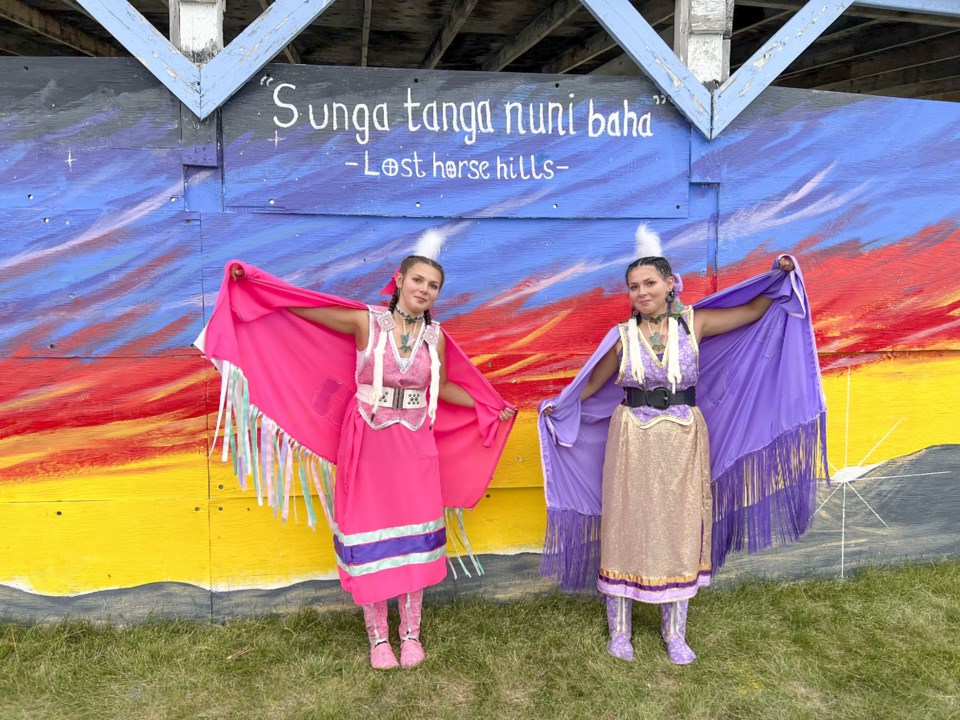OCEAN MAN FIRST NATION - The gravel road leading to the Lost Horse Hills powwow was filled with a trail of dust, as vehicles ascended down the hill to the valley where the powwow would be held.
Ocean Man First Nation held their competitive powwow from Sept. 8-10 with the grand entry dance on the opening night.
As the drum groups quietly practiced, the crowd slowly grew, stands began to fill and lawn chairs were placed around the circle.
According to Chief Connie BigEagle, Ocean Man people do not compete in their own powwows; this is protocol. They did enter the grand entrance but did not take part in the dancing competition as this is disrespectful to those that have been invited to dance from other groups.
The grounds have seen a few upgrades, with the facia being replaced and painted to match the roof of the medicine wheel colours, along with the posts that surround the arbor for parking.
The host drums, Dakota Travels, began to drum and sing in the evening of Sept. 8, as the ceremony began. The flag carriers followed the scent of the sage.
The smoke from the white sage called artemisia califoncia is used to purify the mind, body and spirit. White sage is also used for smudging, as well as cleansing of spirit and dwellings. It is a sacred ceremony.
Announcers Vern Chocan and Amos McArthur welcomed everyone to the powwow and kept the crowd engaged in the event.
Invited drum groups were Wooden Face, Pipestone Dakota, Iron Whistle and Yellow Creek. The local youth drum was Oshina Mani Kosha.
Dancers followed the flag carriers as the jingles of their regalia danced with the beat of the drum.
The circle filled with bright colours and scarves until everyone present from the elders and the small children had made it into the center.
Each regalia worn has meaning to each person that wears it. At times regalia is handed down and each tells a story. The colour of the material, placing of the beads, the design and patterns all are placed and made by a special person.
Food booth vendors were not in short supply as they surrounded the arbor to feed the large crowd. Crafts were displayed and over 50 campers enjoyed the full weekend.
Security greeted everyone at the gate to ensure there were no drugs and alcohol, and they remained on the grounds throughout the weekend.
Grand entrance was held twice on Sept. 9, and the final entrance was on Sept. 10.
Arena director Glenn Pelltier and co-director Tim Delorme made sure everything moved along smoothly.
C and T Tabulator kept track of the scores, with winners announced on the final day.
Dance categories included men and women’s golden age for those over 65; seniors' adults for 40-64 years of age, junior adults aged 18-39, teens 13-17, juniors aged 7-12, and tiny tots under six years of age.
Sept. 9 offered some special dances with a sweetheart team dance, dance your own style rock and roll, junior boys' traditional and the broom dance. Like the regalia, each step and placement of the foot is important in the dance and has deep meaning.
A fireworks display on Sept. 9 was put on by Ocean Man Housing.
On Sept. 10 they honoured Every Inner Child Matters, remembering all those who survived the residential schools and all the children.
Also that day the Missing and Murdered Indigenous Women and Girls' red dress honourings was held. Participants over the age of 16 sporting red regalia could enter in this all-women’s category.
Approximately 200 dancers entered the circle each day, in the hopes that their dance and regalia would be enough to score points for the final prize money.
As the drums went silent and the jingles no longer danced, the Ocean Man First Nations powwow came to an end.
The gravel road once more filled with dust as the campers left and the Lost Horse Hills grounds fell silent for another year.




